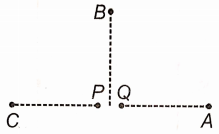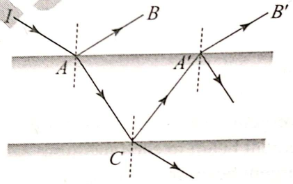| 1. | \(\dfrac{\sqrt{n}}{n+1}\) | 2. | \(\dfrac{2\sqrt{n}}{n+1}\) |
| 3. | \(\dfrac{\sqrt{n}}{(n+1)^2}\) | 4. | \(\dfrac{2\sqrt{n}}{(n+1)^2}\) |
The intensity at the maximum in Young's double-slit experiment is \(I_0\). The distance between the two slits is \(d= 5\lambda\), where \(\lambda \) is the wavelength of light used in the experiment. What will be the intensity in front of one of the slits on the screen placed at a distance \(D = 10 d\)?
1. \(\dfrac{I_0}{4}\)
2. \(\dfrac{3}{4}I_0\)
3. \(\dfrac{I_0}{2}\)
4. \(I_0\)
At the first minimum adjacent to the central maximum of a single slit diffraction pattern, the phase difference between the Huygen’s wavelet from the edge of the slit and the wavelet from the midpoint of the slit is:
1. \(\dfrac{\pi}{4}~\text{radian}\)
2. \(\dfrac{\pi}{2}~\text{radian}\)
3. \({\pi}~\text{radian}\)
4. \(\dfrac{\pi}{8}~\text{radian}\)
| 1. | The angular width of the central maximum of the diffraction pattern will increase. |
| 2. | The angular width of the central maximum will decrease. |
| 3. | The angular width of the central maximum will be unaffected. |
| 4. | A diffraction pattern is not observed on the screen in the case of electrons. |
In YDSE, refer to figure, d >> and . The central bright fringe is obtained at distance x above Point C, then x is:

1.
2.
3. 2D
4. Zero
The main difference between the phenomena of interference and diffraction is that:
1. diffraction is caused by reflected waves from a source whereas interference is caused due to the refraction of waves from a source.
2. diffraction is due to the interaction of waves derived from the same source, whereas interference is the bending of light from the same wavefront.
3. diffraction is due to the interaction of light from the same wavefront, whereas the interference is the interaction of two waves derived from the same source.
4. diffraction is due to the interaction of light from the same wavefront whereas interference is the interaction of waves from two isolated sources.
An astronomical refracting telescope will have large angular magnification and high angular resolution when it has an objective lens of:
| 1. | small focal length and large diameter. |
| 2. | large focal length and small diameter. |
| 3. | large focal length and large diameter. |
| 4. | small focal length and small diameter. |
The figure here shows P and Q as two equally intense coherent sources emitting radiations of wavelength 20 m. The separation PQ is 5.0 m and the phase of P is ahead of the phase of Q by 90. A, B, and C are three distant points of observation equidistant
from the midpoint of PQ. The intensity of radiations at A, B, C will bear the ratio:

1. 0:1:4
2. 4:1:0
3. 0:1:2
4. 2:1:0
The separation between successive fringes in a double-slit arrangement is x. If the whole arrangement is dipped underwater, what will be the new fringe separation? [The wavelength of light being used is 5000 ]
1. 1.5 x
2. x
3. 0.75 x
4. 2 x
In Young's double-slit experiment, the separation \(d\) between the slits is \(2~\text{mm}\), the wavelength \(\lambda\) of the light used is \(5896~\mathring{A}\) and distance \(D\) between the screen and slits is \(100~\text{cm}\). It is found that the angular width of the fringes is \(0.20^{\circ}\). To increase the fringe angular width to \(0.21^{\circ}\) (with same \(\lambda\) and \(D\)) the separation between the slits needs to be changed to:
1. \(1.8~\text{mm}\)
2. \(1.9~\text{mm}\)
3. \(2.1~\text{mm}\)
4. \(1.7~\text{mm}\)
Two polaroids \(P_1\) and \(P_2\) are placed with their axis perpendicular to each other. Unpolarised light of intensity \(I_0\) is incident on \(P_1\). A third polaroid \(P_3\) is kept in between \(P_1\) and \(P_2\) such that its axis makes an angle \(45^\circ\) with that of \(P_1\). The intensity of transmitted light through \(P_2\) is:
1. \(\dfrac{I_0}{4}\)
2. \(\dfrac{I_0}{8}\)
3. \(\dfrac{I_0}{16}\)
4. \(\dfrac{I_0}{2}\)
A ray of light of intensity I is incident on a parallel glass-slab at point A as shown in the figure. It undergoes partial reflection and refraction. At each reflection, 25% of incident energy is reflected. The rays AB and A'B' undergo interference. The ratio is

1. 4:1
2. 8:1
3. 7:1
4. 49:1
Yellow light is used in a single slit diffraction experiment with slit width 0.6 mm. If the yellow light is replaced by X-rays then the pattern will reveal:
1. that the central maxima is narrower
2. no diffraction pattern
3. more number of fringes
4. less number of fringes